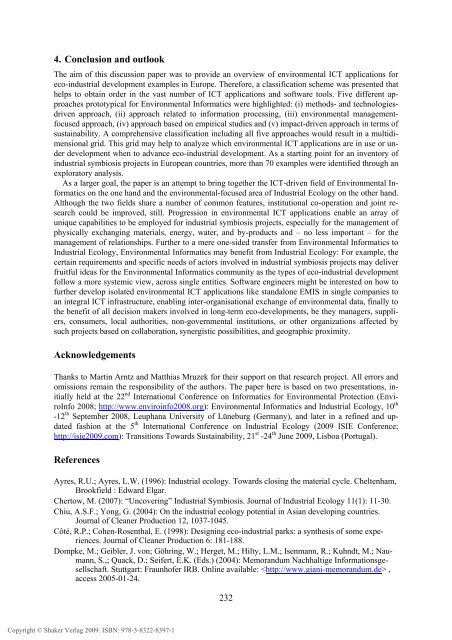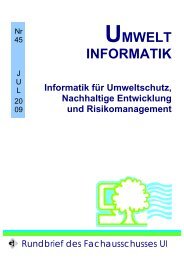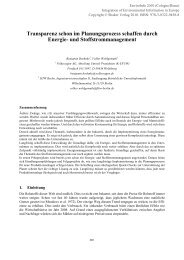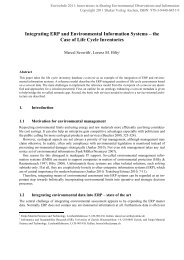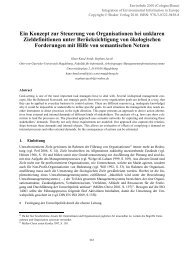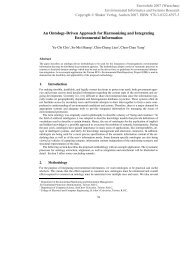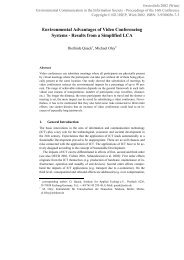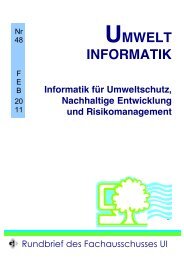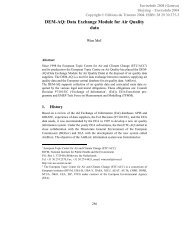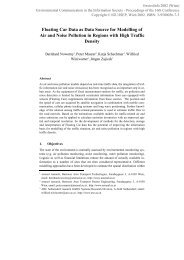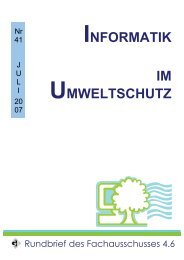Environmental ICT applications for eco-industrial ... - EnviroInfo
Environmental ICT applications for eco-industrial ... - EnviroInfo
Environmental ICT applications for eco-industrial ... - EnviroInfo
You also want an ePaper? Increase the reach of your titles
YUMPU automatically turns print PDFs into web optimized ePapers that Google loves.
4. Conclusion and outlook<br />
The aim of this discussion paper was to provide an overview of environmental <strong>ICT</strong> <strong>applications</strong> <strong>for</strong><br />
<strong>eco</strong>-<strong>industrial</strong> development examples in Europe. There<strong>for</strong>e, a classification scheme was presented that<br />
helps to obtain order in the vast number of <strong>ICT</strong> <strong>applications</strong> and software tools. Five different approaches<br />
prototypical <strong>for</strong> <strong>Environmental</strong> In<strong>for</strong>matics were highlighted: (i) methods- and technologiesdriven<br />
approach, (ii) approach related to in<strong>for</strong>mation processing, (iii) environmental managementfocused<br />
approach, (iv) approach based on empirical studies and (v) impact-driven approach in terms of<br />
sustainability. A comprehensive classification including all five approaches would result in a multidimensional<br />
grid. This grid may help to analyze which environmental <strong>ICT</strong> <strong>applications</strong> are in use or under<br />
development when to advance <strong>eco</strong>-<strong>industrial</strong> development. As a starting point <strong>for</strong> an inventory of<br />
<strong>industrial</strong> symbiosis projects in European countries, more than 70 examples were identified through an<br />
exploratory analysis.<br />
As a larger goal, the paper is an attempt to bring together the <strong>ICT</strong>-driven field of <strong>Environmental</strong> In<strong>for</strong>matics<br />
on the one hand and the environmental-focused area of Industrial Ecology on the other hand.<br />
Although the two fields share a number of common features, institutional co-operation and joint research<br />
could be improved, still. Progression in environmental <strong>ICT</strong> <strong>applications</strong> enable an array of<br />
unique capabilities to be employed <strong>for</strong> <strong>industrial</strong> symbiosis projects, especially <strong>for</strong> the management of<br />
physically exchanging materials, energy, water, and by-products and – no less important – <strong>for</strong> the<br />
management of relationships. Further to a mere one-sided transfer from <strong>Environmental</strong> In<strong>for</strong>matics to<br />
Industrial Ecology, <strong>Environmental</strong> In<strong>for</strong>matics may benefit from Industrial Ecology: For example, the<br />
certain requirements and specific needs of actors involved in <strong>industrial</strong> symbiosis projects may deliver<br />
fruitful ideas <strong>for</strong> the <strong>Environmental</strong> In<strong>for</strong>matics community as the types of <strong>eco</strong>-<strong>industrial</strong> development<br />
follow a more systemic view, across single entities. Software engineers might be interested on how to<br />
further develop isolated environmental <strong>ICT</strong> <strong>applications</strong> like standalone EMIS in single companies to<br />
an integral <strong>ICT</strong> infrastructure, enabling inter-organisational exchange of environmental data, finally to<br />
the benefit of all decision makers involved in long-term <strong>eco</strong>-developments, be they managers, suppliers,<br />
consumers, local authorities, non-governmental institutions, or other organizations affected by<br />
such projects based on collaboration, synergistic possibilities, and geographic proximity.<br />
Acknowledgements<br />
Thanks to Martin Arntz and Matthias Mruzek <strong>for</strong> their support on that research project. All errors and<br />
omissions remain the responsibility of the authors. The paper here is based on two presentations, initially<br />
held at the 22 nd International Conference on In<strong>for</strong>matics <strong>for</strong> <strong>Environmental</strong> Protection (<strong>EnviroInfo</strong><br />
2008; http://www.enviroinfo2008.org): <strong>Environmental</strong> In<strong>for</strong>matics and Industrial Ecology, 10 th<br />
-12 th September 2008, Leuphana University of Lüneburg (Germany), and later in a refined and updated<br />
fashion at the 5 th International Conference on Industrial Ecology (2009 ISIE Conference;<br />
http://isie2009.com): Transitions Towards Sustainability, 21 st -24 th June 2009, Lisboa (Portugal).<br />
References<br />
Ayres, R.U.; Ayres, L.W. (1996): Industrial <strong>eco</strong>logy. Towards closing the material cycle. Cheltenham,<br />
Brookfield : Edward Elgar.<br />
Chertow, M. (2007): “Uncovering” Industrial Symbiosis. Journal of Industrial Ecology 11(1): 11-30.<br />
Chiu, A.S.F.; Yong, G. (2004): On the <strong>industrial</strong> <strong>eco</strong>logy potential in Asian developing countries.<br />
Journal of Cleaner Production 12, 1037-1045.<br />
Côté, R.P.; Cohen-Rosenthal, E. (1998): Designing <strong>eco</strong>-<strong>industrial</strong> parks: a synthesis of some experiences.<br />
Journal of Cleaner Production 6: 181-188.<br />
Dompke, M.; Geibler, J. von; Göhring, W.; Herget, M.; Hilty, L.M.; Isenmann, R.; Kuhndt, M.; Naumann,<br />
S.,; Quack, D.; Seifert, E.K. (Eds.) (2004): Memorandum Nachhaltige In<strong>for</strong>mationsgesellschaft.<br />
Stuttgart: Fraunhofer IRB. Online available: ,<br />
access 2005-01-24.<br />
232<br />
Copyright © Shaker Verlag 2009. ISBN: 978-3-8322-8397-1


